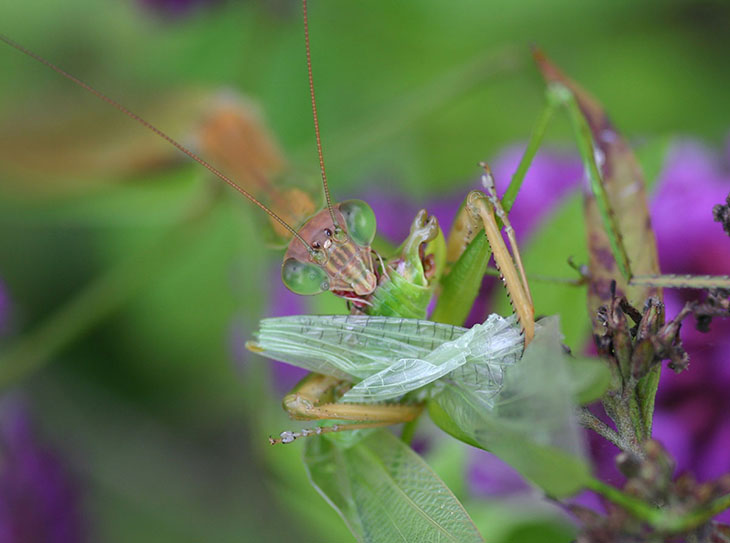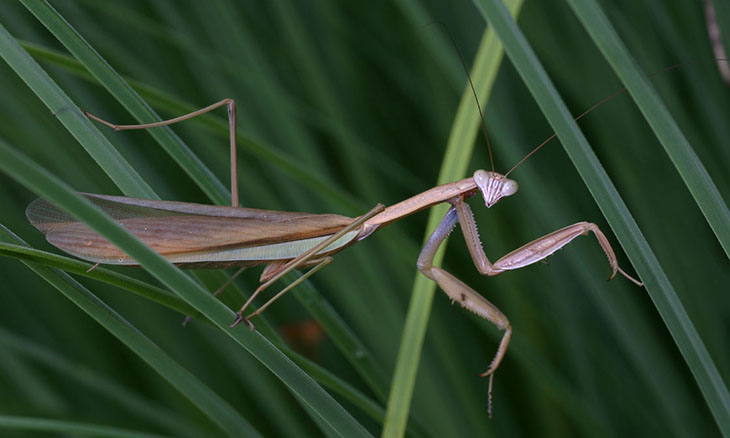
This is the follow-up to several different posts made earlier in the year – it gives an indication not just of what life in the arthropod world is like, but how I pursue nature photography as well.
Since the beginning of the year, there have been five areas of the front yard that served as “photo subject preserves,” areas where I could frequently find something to photograph. Early on it was the holly trees, only a little taller than I am, and the only thing green during the slow arrival of spring. These have long since become almost barren for buggy life, since too many other choices are better now.
The azalea bushes right off the porch were the next go-to, hosting the juvenile mantises and the green lynx spiders. In the periods just before and after blooming, they were brimming with chitiny residents, and thick enough to provide plenty of hiding spaces. But as the days’ heat became more intense and the flowers died off, many things moved away.
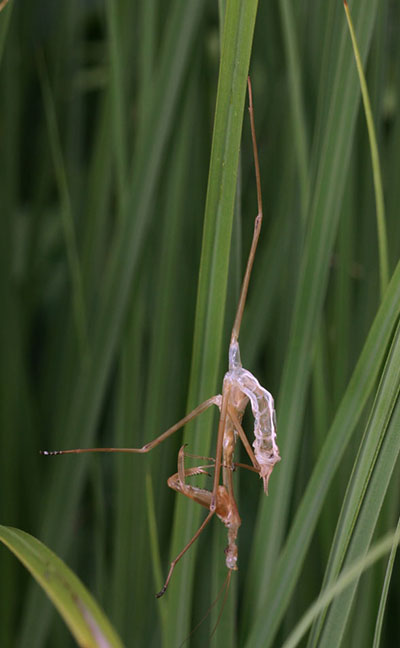 The first to go were the mantises, which departed in several directions – one that I knew of made its way completely around the house before vanishing for good. But two others began to inhabit the pampas grass patches, once they had grown to decent size. These are plants that do best when cut back and burned off in the winter, one of those tasks I view with mixed feelings. We have two different species, but both possess nasty leaves that can slice into skin surprisingly well, one more so than the other, which means cutting them back in the winter requires heavy sleeves and gloves, and still results in numerous “paper cuts.” But the pyromaniac in me (I’m male – ’nuff said) appreciates the burning part, since by that time they’re dry and catch easily. But this means they start the year as blackened stumps and take a bit of time before they’re thick reedy clumps up to three meters in height, becoming attractive to the mantises by then – each year they’ve played home to several.
The first to go were the mantises, which departed in several directions – one that I knew of made its way completely around the house before vanishing for good. But two others began to inhabit the pampas grass patches, once they had grown to decent size. These are plants that do best when cut back and burned off in the winter, one of those tasks I view with mixed feelings. We have two different species, but both possess nasty leaves that can slice into skin surprisingly well, one more so than the other, which means cutting them back in the winter requires heavy sleeves and gloves, and still results in numerous “paper cuts.” But the pyromaniac in me (I’m male – ’nuff said) appreciates the burning part, since by that time they’re dry and catch easily. But this means they start the year as blackened stumps and take a bit of time before they’re thick reedy clumps up to three meters in height, becoming attractive to the mantises by then – each year they’ve played home to several.
One morning after a rain I found a molted mantis skin dangling from the pampas grass, and soon found the newly-emerged adult (top photo,) identified as such by her new wings. What had been an eentsy hatchling not a centimeter long was now a formidable insect the length of my palm. She remained in the pampas for just a few days before deciding that she needed a new home, perhaps prompted by the mating drive. So she moved to the butterfly bush.
This had been planted in the middle of the yard in the hopes of attracting hummingbirds, which it didn’t accomplish, and pollinators, which it did. It’s rather small to accommodate an adult mantis, but she made the most of the attractive properties of the flowers. At one point, I caught a katydid and moved it from the thick obscuring clusters of the dog fennel plants (more on them in a moment) to the butterfly bush for pics, then left it there and watched. Katydids make hearty meals for mantids, and I didn’t have long to wait since the katydid wasn’t holding still.
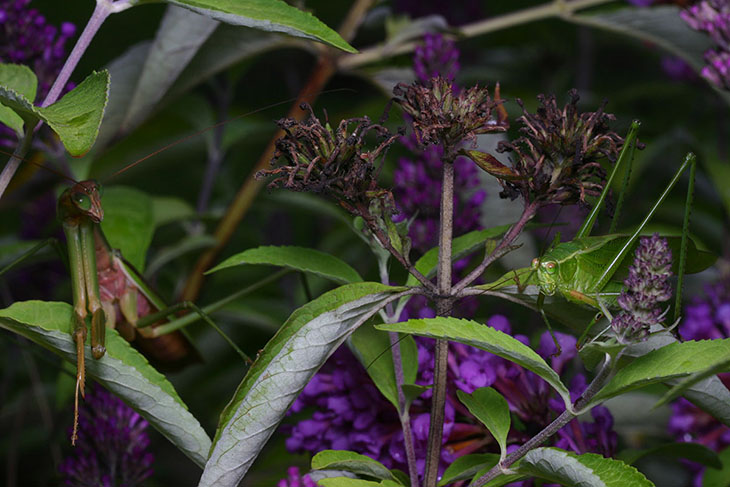
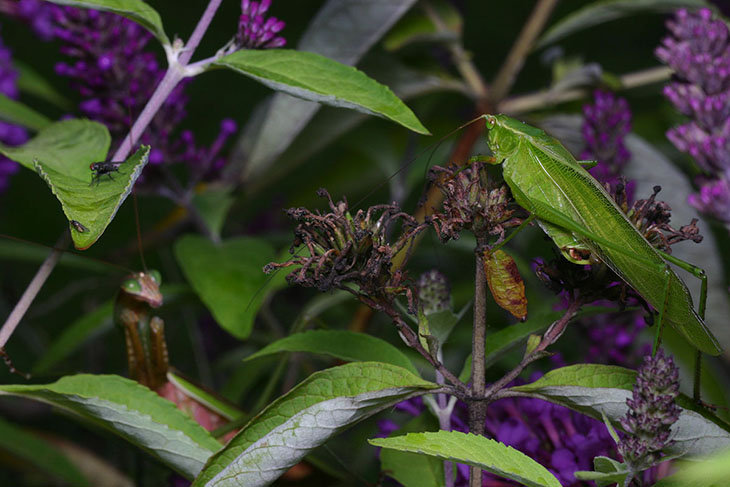
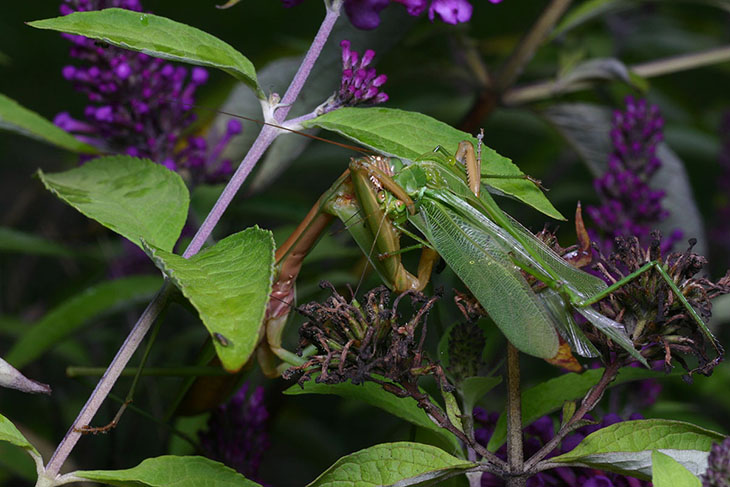
There’s a mantis egg case coming soon, and I was hoping she’d choose to put it on the easy-to-monitor butterfly bush, but she moved off after a few days and has appeared in various locations around the yard.
Before she did so, however, she had a brief standoff with another resident of the bush, a green lynx spider. They sat facing one another for a long time, the mantis even tapping the spider on the back with its antenna, twice, but then the spider caught a fly and the mantis lost interest. Here I thought the distraction would have been the opening the mantis was waiting for, but it appears instead it was just a game of staredown.
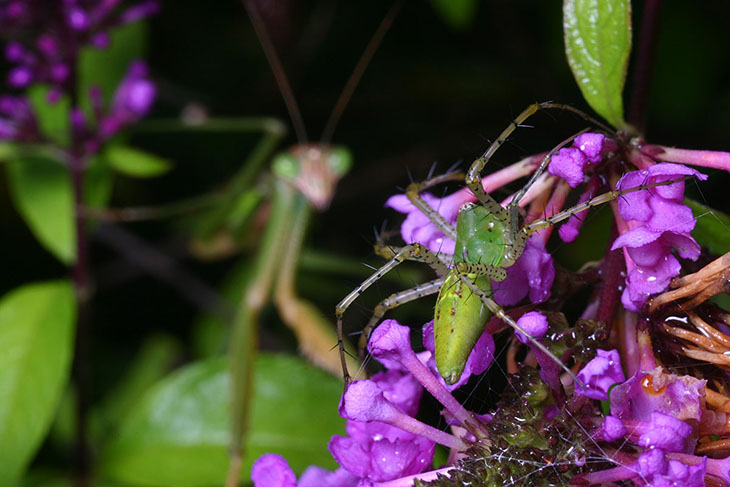
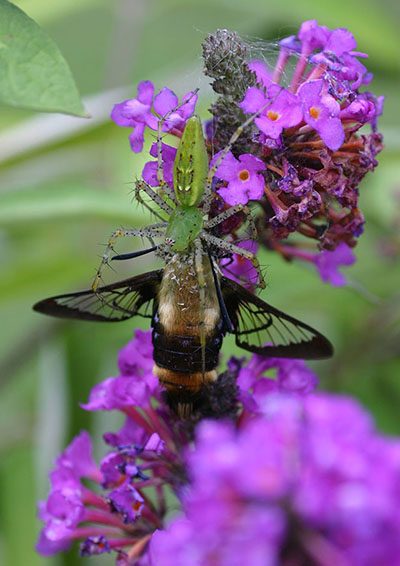 I’m almost positive the green lynx spider is one of the many that hatched out of a case on the pampas grass last fall, and first reappeared this spring on the azaleas. After a long period they left those bushes and three took up residence on the butterfly bush, where they ate like gluttons. Especially impressive is that they caught several of the Hemaris moths that I’ve chased earlier, surprising to me because of the size of the moths and the fact that they don’t land, but lynx spiders are wicked hunters. I’d love to show you a sequence of capture images, but there would be nothing to see without investing in some expensive equipment – it’s all over in a fraction of a second, and even a single frame would require either blind luck or timing that I, so far, haven’t nailed. But I’ve had the chance to see which butterflies are better than others at escaping the pounce, and one species of pollinator, common on the bush, that the spiders avoid. I also observed one of the spiders appearing rather agitated, making motions almost as if it was wrapping prey in webbing (which lynxes don’t do) while nothing was there. Then a nasty stench came to me, and I suspected that she had attempted to catch one of the stink bugs that frequent the bush. Since I never saw the bug I was never able to confirm this (she would have dropped it in the litter beneath the bush,) but the smell was pretty strong evidence. Heh.
I’m almost positive the green lynx spider is one of the many that hatched out of a case on the pampas grass last fall, and first reappeared this spring on the azaleas. After a long period they left those bushes and three took up residence on the butterfly bush, where they ate like gluttons. Especially impressive is that they caught several of the Hemaris moths that I’ve chased earlier, surprising to me because of the size of the moths and the fact that they don’t land, but lynx spiders are wicked hunters. I’d love to show you a sequence of capture images, but there would be nothing to see without investing in some expensive equipment – it’s all over in a fraction of a second, and even a single frame would require either blind luck or timing that I, so far, haven’t nailed. But I’ve had the chance to see which butterflies are better than others at escaping the pounce, and one species of pollinator, common on the bush, that the spiders avoid. I also observed one of the spiders appearing rather agitated, making motions almost as if it was wrapping prey in webbing (which lynxes don’t do) while nothing was there. Then a nasty stench came to me, and I suspected that she had attempted to catch one of the stink bugs that frequent the bush. Since I never saw the bug I was never able to confirm this (she would have dropped it in the litter beneath the bush,) but the smell was pretty strong evidence. Heh.
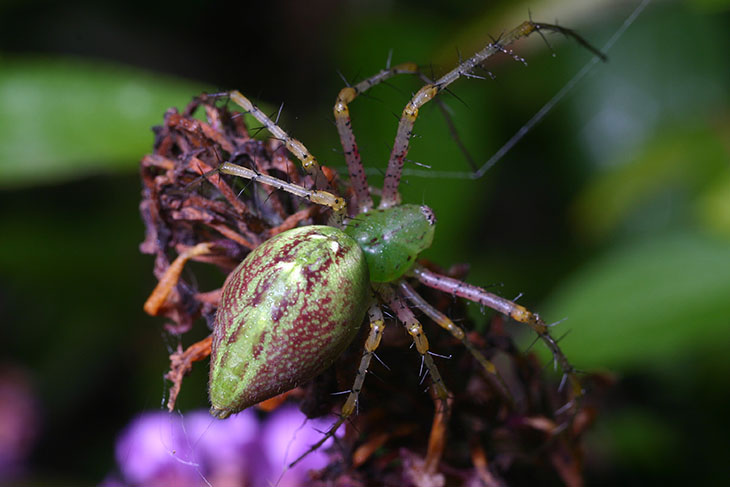
One lynx spider vacated the bush quickly for points unknown (potentially even something’s stomach,) while two others set up shop in the bush for weeks, getting rather rotund in anticipation of laying eggs. Another specimen appeared on the rosemary bush and quickly spun her own egg sac therein, though she wasn’t anywhere near the girth of the one shown here (who did eventually produce her own eggs.) And one of the butterfly bush residents took advantage of a windy night and transferred to the dog fennel to create a third – I can always tell when the night has been breezy because the yard is crisscrossed with strands of web cast by traveling spiders.
The dog fennel has been an interesting accident. First appearing where I’d planted a variety of flowers last year, I left it alone because I had no idea what any of the flowers looked like when sprouting, and once I’d determined it wasn’t anything intended, it was already playing host to numerous species, and provided entire galleries of shots last year, mostly of lady beetles. It returned without effort this spring and is three meters tall, again providing homes to arthropods but largely not the same species as last year. The ambush bugs, curiously, have gone through little change while the development of the others species is easy to spot.
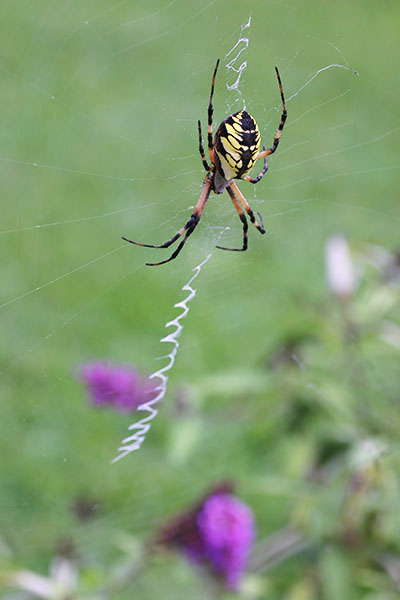 Case in point: the black-and-yellow Argiope aurantia that I perved on earlier, who spent some time within the fennel plants before also deciding the butterfly bush was good pickings and setting up shop there. She has grown to a massive specimen, conspicuously suspended in mid-air over the bush (using one of the hummingbird feeders as an anchor and preventing me from refilling it – there are two more, so don’t fret.) Yet she’s gorging on swallowtail butterflies that can’t take the hint that there’s a web there. She has had a succession of suitors, which I’m able to differentiate because the number of legs keeps switching. I got to see one that was more agile than the first I’d photographed; once he’d get down to business and the female would make a sudden aggressive move, he would instantly drop out from under her to dangle 20cm beneath on his own safety line, giving her a few moments to cool down before making the attempt again. If anyone is annoyed at the dogged persistence of frat boys on the prowl, this is evidence that they’re closely related to spiders – feel free to quote me on that. Meanwhile, I would guess that someone was successful, except that making this assumption based on her waistline is one of those things you’re never supposed to do. I’ll know for sure when the egg sac appears.
Case in point: the black-and-yellow Argiope aurantia that I perved on earlier, who spent some time within the fennel plants before also deciding the butterfly bush was good pickings and setting up shop there. She has grown to a massive specimen, conspicuously suspended in mid-air over the bush (using one of the hummingbird feeders as an anchor and preventing me from refilling it – there are two more, so don’t fret.) Yet she’s gorging on swallowtail butterflies that can’t take the hint that there’s a web there. She has had a succession of suitors, which I’m able to differentiate because the number of legs keeps switching. I got to see one that was more agile than the first I’d photographed; once he’d get down to business and the female would make a sudden aggressive move, he would instantly drop out from under her to dangle 20cm beneath on his own safety line, giving her a few moments to cool down before making the attempt again. If anyone is annoyed at the dogged persistence of frat boys on the prowl, this is evidence that they’re closely related to spiders – feel free to quote me on that. Meanwhile, I would guess that someone was successful, except that making this assumption based on her waistline is one of those things you’re never supposed to do. I’ll know for sure when the egg sac appears.
In closing, I’ll leave you with another image of the mantis, shutting off the flash this time and shooting wide-open in the dim, soft light of approaching rain. The short focus effect made an almost surreal tableau that I’m rather pleased with.
